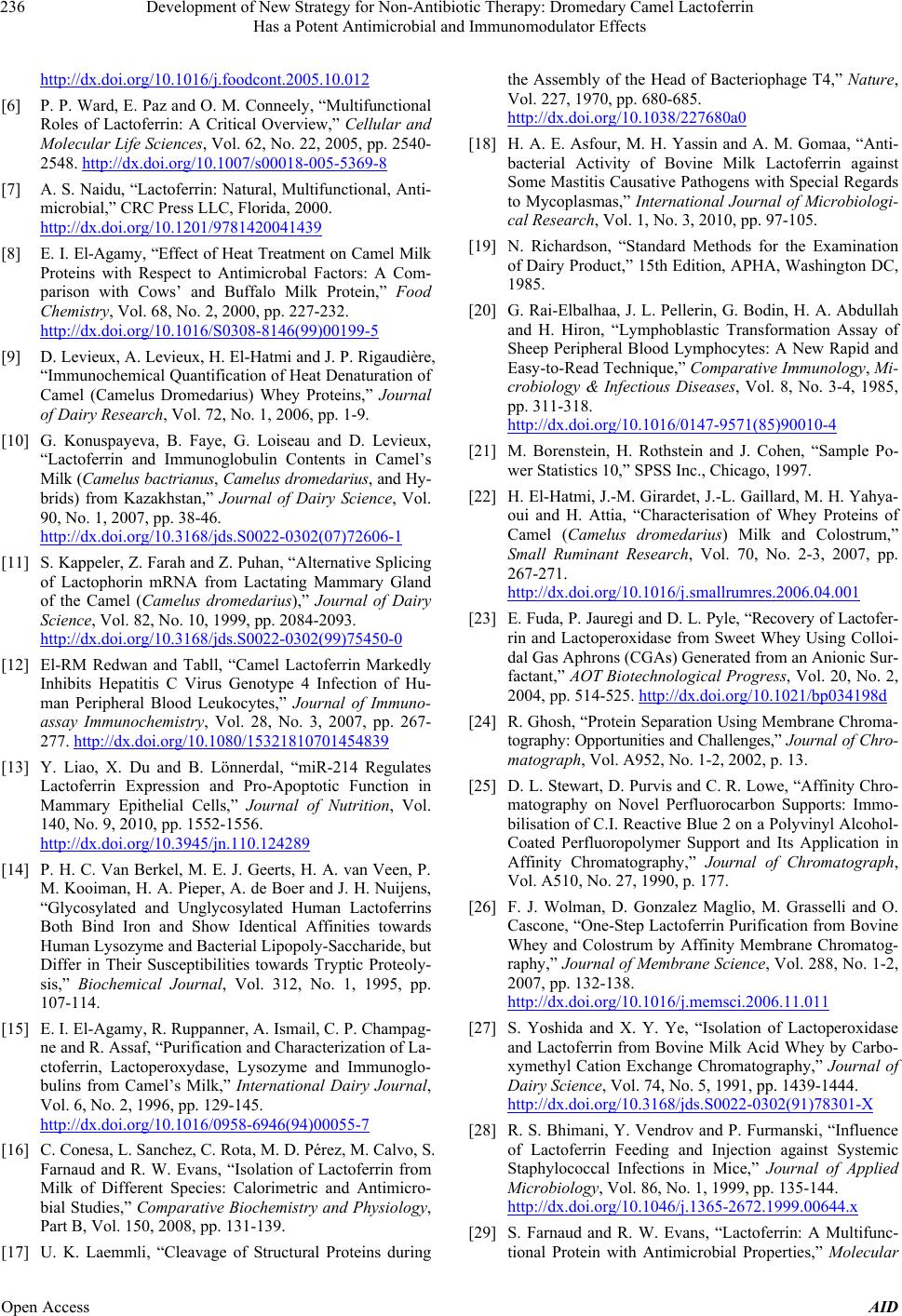
Development of New Strategy for Non-Antibiotic Therapy: Dromedary Camel Lactoferrin
Has a Potent Antimicrobial and Immunomodulator Effects
236
http://dx.doi.org/10.1016/j.foodcont.2005.10.012
[6] P. P. Ward, E. Paz and O. M. Conneely, “Multifunctional
Roles of Lactoferrin: A Critical Overview,” Cellular and
Molecular Life Sciences, Vol. 62, No. 22, 2005, pp. 2540-
2548. http://dx.doi.org/10.1007/s00018-005-5369-8
[7] A. S. Naidu, “Lactoferrin: Natural, Multifunctional, Anti-
microbial,” CRC Press LLC, Florida, 2000.
http://dx.doi.org/10.1201/9781420041439
[8] E. I. El-Agamy, “Effect of Heat Treatment on Camel Milk
Proteins with Respect to Antimicrobal Factors: A Com-
parison with Cows’ and Buffalo Milk Protein,” Food
Chemistry, Vol. 68, No. 2, 2000, pp. 227-232.
http://dx.doi.org/10.1016/S0308-8146(99)00199-5
[9] D. Levieux, A. Levieux, H. El-Hatmi and J. P. Rigaudière,
“Immunochemical Quantification of Heat Denaturation of
Camel (Camelus Dromedarius) Whey Proteins,” Journal
of Dairy Research, Vol. 72, No. 1, 2006, pp. 1-9.
[10] G. Konuspayeva, B. Faye, G. Loiseau and D. Levieux,
“Lactoferrin and Immunoglobulin Contents in Camel’s
Milk (Camelus bactrianus, Camel us dromedarius, and Hy-
brids) from Kazakhstan,” Journal of Dairy Science, Vol.
90, No. 1, 2007, pp. 38-46.
http://dx.doi.org/10.3168/jds.S0022-0302(07)72606-1
[11] S. Kappeler, Z. Farah and Z. Puhan, “Alternative Splicing
of Lactophorin mRNA from Lactating Mammary Gland
of the Camel (Camelus dromedarius),” Journal of Dairy
Science, Vol. 82, No. 10, 1999, pp. 2084-2093.
http://dx.doi.org/10.3168/jds.S0022-0302(99)75450-0
[12] El-RM Redwan and Tabll, “Camel Lactoferrin Markedly
Inhibits Hepatitis C Virus Genotype 4 Infection of Hu-
man Peripheral Blood Leukocytes,” Journal of Immuno-
assay Immunochemistry, Vol. 28, No. 3, 2007, pp. 267-
277. http://dx.doi.org/10.1080/15321810701454839
[13] Y. Liao, X. Du and B. Lönnerdal, “miR-214 Regulates
Lactoferrin Expression and Pro-Apoptotic Function in
Mammary Epithelial Cells,” Journal of Nutrition, Vol.
140, No. 9, 2010, pp. 1552-1556.
http://dx.doi.org/10.3945/jn.110.124289
[14] P. H. C. Van Berkel, M. E. J. Geerts, H. A. van Veen, P.
M. Kooiman, H. A. Pieper, A. de Boer and J. H. Nuijens,
“Glycosylated and Unglycosylated Human Lactoferrins
Both Bind Iron and Show Identical Affinities towards
Human Lysozyme and Bacterial Lipopoly-Saccharide, but
Differ in Their Susceptibilities towards Tryptic Proteoly-
sis,” Biochemical Journal, Vol. 312, No. 1, 1995, pp.
107-114.
[15] E. I. El-Agamy, R. Ruppanner, A. Ismail, C. P. Champag-
ne and R. Assaf, “Purification and Characterization of La-
ctoferrin, Lactoperoxydase, Lysozyme and Immunoglo-
bulins from Camel’s Milk,” International Dairy Journal,
Vol. 6, No. 2, 1996, pp. 129-145.
http://dx.doi.org/10.1016/0958-6946(94)00055-7
[16] C. Conesa, L. Sanchez, C. Rota, M. D. Pérez, M. Calvo, S.
Farnaud and R. W. Evans, “Isolation of Lactoferrin from
Milk of Different Species: Calorimetric and Antimicro-
bial Studies,” Comparative Biochemistry and Physiology,
Part B, Vol. 150, 2008, pp. 131-139.
[17] U. K. Laemmli, “Cleavage of Structural Proteins during
the Assembly of the Head of Bacteriophage T4,” Nature,
Vol. 227, 1970, pp. 680-685.
http://dx.doi.org/10.1038/227680a0
[18] H. A. E. Asfour, M. H. Yassin and A. M. Gomaa, “Anti-
bacterial Activity of Bovine Milk Lactoferrin against
Some Mastitis Causative Pathogens with Special Regards
to Mycoplasmas,” International Journal of Microbiologi-
cal Research, Vol. 1, No. 3, 2010, pp. 97-105.
[19] N. Richardson, “Standard Methods for the Examination
of Dairy Product,” 15th Edition, APHA, Washington DC,
1985.
[20] G. Rai-Elbalhaa, J. L. Pellerin, G. Bodin, H. A. Abdullah
and H. Hiron, “Lymphoblastic Transformation Assay of
Sheep Peripheral Blood Lymphocytes: A New Rapid and
Easy-to-Read Technique,” Comparative Immunology, Mi-
crobiology & Infectious Diseases, Vol. 8, No. 3-4, 1985,
pp. 311-318.
http://dx.doi.org/10.1016/0147-9571(85)90010-4
[21] M. Borenstein, H. Rothstein and J. Cohen, “Sample Po-
wer Statistics 10,” SPSS Inc., Chicago, 1997.
[22] H. El-Hatmi, J.-M. Girardet, J.-L. Gaillard, M. H. Yahya-
oui and H. Attia, “Characterisation of Whey Proteins of
Camel (Camelus dromedarius) Milk and Colostrum,”
Small Ruminant Research, Vol. 70, No. 2-3, 2007, pp.
267-271.
http://dx.doi.org/10.1016/j.smallrumres.2006.04.001
[23] E. Fuda, P. Jauregi and D. L. Pyle, “Recovery of Lactofer-
rin and Lactoperoxidase from Sweet Whey Using Colloi-
dal Gas Aphrons (CGAs) Generated from an Anionic Sur-
factant,” AOT Biotechnological Progress, Vol. 20, No. 2,
2004, pp. 514-525. http://dx.doi.org/10.1021/bp034198d
[24] R. Ghosh, “Protein Separation Using Membrane Chroma-
tography: Opportunities and Challenges,” Journal of Chro-
matograph, Vol. A952, No. 1-2, 2002, p. 13.
[25] D. L. Stewart, D. Purvis and C. R. Lowe, “Affinity Chro-
matography on Novel Perfluorocarbon Supports: Immo-
bilisation of C.I. Reactive Blue 2 on a Polyvinyl Alcohol-
Coated Perfluoropolymer Support and Its Application in
Affinity Chromatography,” Journal of Chromatograph,
Vol. A510, No. 27, 1990, p. 177.
[26] F. J. Wolman, D. Gonzalez Maglio, M. Grasselli and O.
Cascone, “One-Step Lactoferrin Purification from Bovine
Whey and Colostrum by Affinity Membrane Chromatog-
raphy,” Journal of Membrane Science, Vol. 288, No. 1-2,
2007, pp. 132-138.
http://dx.doi.org/10.1016/j.memsci.2006.11.011
[27] S. Yoshida and X. Y. Ye, “Isolation of Lactoperoxidase
and Lactoferrin from Bovine Milk Acid Whey by Carbo-
xymethyl Cation Exchange Chromatography,” Journal of
Dairy Science, Vol. 74, No. 5, 1991, pp. 1439-1444.
http://dx.doi.org/10.3168/jds.S0022-0302(91)78301-X
[28] R. S. Bhimani, Y. Vendrov and P. Furmanski, “Influence
of Lactoferrin Feeding and Injection against Systemic
Staphylococcal Infections in Mice,” Journal of Applied
Microbiology, Vol. 86, No. 1, 1999, pp. 135-144.
http://dx.doi.org/10.1046/j.1365-2672.1999.00644.x
[29] S. Farnaud and R. W. Evans, “Lactoferrin: A Multifunc-
tional Protein with Antimicrobial Properties,” Molecular
Open Access AID